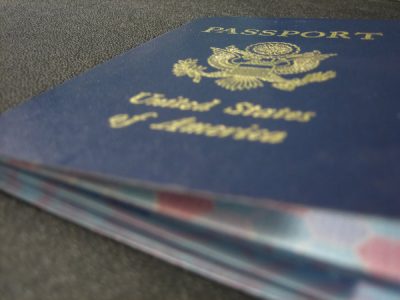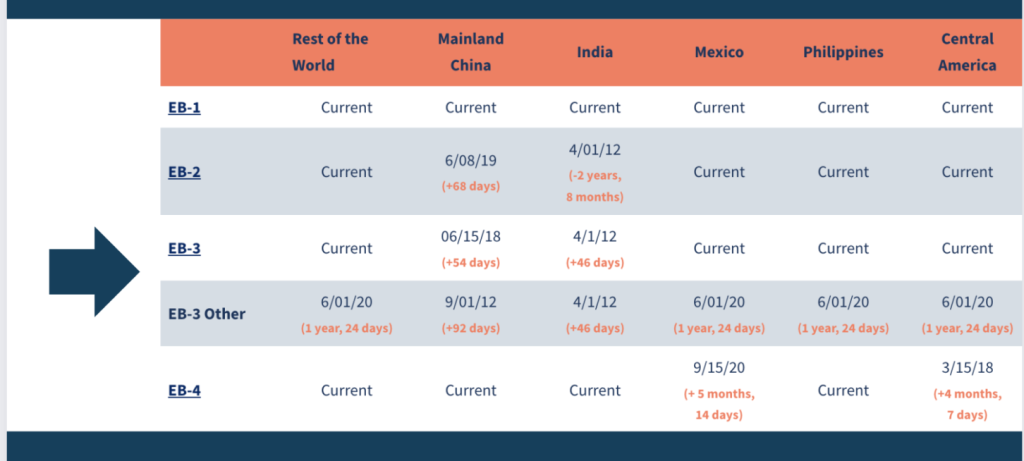
Many people choose to work temporarily in the U.S. through nonimmigrant visas, but others want to make this country their permanent home. Immigrant visas, or green cards, allow these foreign nationals to live and work in the U.S. for ten years at a time. One of the more common types of green cards that people seek is the EB-3 green card due to its relatively low requirements. However, this popularity can impact the time it takes to obtain one. Keep reading to find out what else goes into the EB-3 visa processing time in 2023.
To understand and estimate how long it takes to get an EB-3, we must first go over the steps involved in preparing and petitioning for this green card.
The EB-3 is an employment-based immigrant visa that is on the third preference level. Because of this, the requirements are not as stringent as they are for the second and first preference levels.
There is no need to have a master’s degree, prove exceptional abilities or achievements, or become an executive in a company. To be considered eligible for an EB-3, you simply need to qualify for one of the following three categories:
You must go through the usual employment-based green card process to get this green card.

Your priority date is the day that the USCIS receives your I-140 petition. You need to remember this date when checking the monthly visa bulletin released by the Department of State. Each year, there is a limit on how many immigrant visas are granted in each category. A backlog is created when the limit is exceeded, causing some people to wait several years.
The visa bulletin provides the final action dates for each green card category based on the applicant’s country of origin. Pay attention to the date in your category. Here is an example:
Diana is a nurse from the Philippines who wants to work as a nurse in the U.S. To check if her priority date is current, she should refer to the most recent visa bulletin and locate the third row under the employment-based category. When the date in the Philippines’ column matches or surpasses her priority date, she can apply for a status change and obtain her green card.
The EB-3 processing time poses a challenge. For citizens of certain countries like China and India, the final action dates can be backlogged for over ten years. This waiting time must be considered when estimating the total EB-3 processing time.
However, this is not always the case. Sometimes, the dates for certain charge ability areas become current or remain current, resulting in shorter waiting times for the EB-3 green card compared to the EB-1. Always check the most recent visa bulletin and consult with your immigration attorney to determine how long you will have to wait before adjusting your status or using consular processing.
To understand the allocation of green cards, 28.6% of the total available for foreign workers is designated for the EB-3 category, with no more than 75 visas per country. Due to higher demand than available visas, backlogs are common.
The final action date depends on the green card category and the applicant’s home country. The final action date will fluctuate based on the number of petitions for the EB-3 from each country.
If green cards are available, the final action date is likely to move closer to your priority date. If green cards are not available, there will be no movement from that final action date. If the limit has passed, the date may retrogress or move backward from your priority date. In the October 2022 Visa Bulletin, the Final Action date for India and EB-3 Other was April 1, 2012, which advanced 46 days from the previous bulletin. Consult with your attorney for the most up-to-date EB-3 wait time information for India or other countries. In some cases, porting may be a better option for you.

The question of how long it will take to obtain an EB-3 green card requires breaking down each step of the process.
PERM Labor Certification Processing Time: 6 – 9 Months
The PERM Labor Certification process can take as little as 6 to 9 months after filing the ETA-9089 application. This timeframe does not include the required 30 days of recruitment and the additional 30 days after recruitment before applying. Here’s the breakdown:
Note: If your employer undergoes an audit, it could extend the processing time up to a year and a half.
I-140 Processing Time: Six Months or 15 Days
Under normal circumstances, processing the I-140 petition takes about six months without premium processing. However, if the USCIS determines that your priority date will not be current for some time; your petition may be rescheduled closer to your priority date. With premium processing, the I-140 will be processed within 15 calendar days.
The I-140 premium processing fee is $2,500.
Wait Time for Priority Date: Varies Widely
The wait time for your priority date varies depending on your country of origin. For most countries, the wait time is only a few months. It will also depend on whether you plan to adjust your status in the U.S. or use consular processing outside the U.S. Each route has its own processing times and requirements.
While consular processing may be faster in certain situations, there is a possibility of facing administrative processing, which could increase the overall wait time. Similarly, adjustment of status may also experience delays. Working closely with an immigration attorney is advised to select the best route for your case.
I-485 Petition for Status Adjustment: Four to Six Months
Processing your I-485 petition may take four to six months. There is no way to expedite this processing time. Sometimes, depending on the service center handling your case, it may take longer than six months. To get the most accurate estimate of the EB-3 visa processing time, use the USCIS processing time tool.
Overall, the EB-3 processing time is typically around a year and a half to two years for applicants from countries other than India, China, and the Philippines. For citizens of those three countries, the processing time may be significantly longer. Contact your immigration attorney to explore any possibilities of shortening this time.
Once your priority date is current and your I-140 is approved, you have two options to obtain your green card: adjustment of status or consular processing. Adjustment of status is available for individuals who are already in the U.S. under a nonimmigrant status, such as H-1B, L-1, or E-2 visa. To apply, file an I-485 with the USCIS and wait approximately six months for processing.
On the other hand, those who are not in the U.S. under a nonimmigrant status must undergo consular processing. This involves scheduling an appointment with a U.S. consulate or embassy in their home country. The appointment may take a few weeks to a few months to arrange. During the consular interview, an officer will assess the legitimacy of your case by asking basic and specific questions. The purpose is to verify your identity and ensure your intent to live permanently in the U.S. under EB-3 status.
Consular processing is an option available to those who qualify for adjustment of status. In some cases, it can be a less expensive option and a faster one. While the I-485 takes about six months to process and cannot be expedited, a consular interview scheduled within a few weeks could offer a more favorable overall EB-3 processing time.
The USCIS provides an optional service called premium processing, which expedites the processing of visa petitions using the I-129 or I-140 forms. By paying an additional fee of $1,440, you can shorten the processing time to 15 calendar days. However, premium processing does not expedite any other steps in the EB-3 process.
It’s important to note that premium processing may not be beneficial if your priority date is not current. You cannot adjust your status until your priority date becomes current, even with an approved I-140. Furthermore, premium processing does not increase the likelihood of petition approval. Consult your immigration attorney to determine if premium processing suits your case.
It is also important to note that, if your priority date will not be current for some time, premium processing may not help, as you cannot adjust your status until your priority date is current, even if your I-140 is approved. Also, premium processing will not increase your chances of having your petition approved. Speak with your immigration attorney to learn if this feature is right for your case.
Due to lengthy wait times for certain priority dates, there are situations where applicants gain additional education or qualifications that meet the requirements for an upgraded green card. If you initially applied for an EB-3 and obtained a master’s degree during the wait, you may be eligible to reapply for an EB-2, often referred to as “porting.” However, it’s important to note that this process essentially starts over rather than simply transferring your application.
To be eligible for porting, you would need a different job that requires your new education. This can be achieved either through your current employer or a new one. Here’s an example:
If you are eligible to port your green card and have found a suitable job, the employer sponsoring your new green card will need to obtain a new PERM Labor Certification before filing another I-140. Since this process is complex, it is crucial to work closely with your immigration attorney in such cases.
There are several benefits to having an EB-3 visa, including:
If you choose to process your EB-3 green card outside the U.S., you will need to complete the following steps:
After the NVC approves your DS-261, you need to submit the following supporting documents for consular processing:
Note: The supporting documents may vary depending on the embassy and the individual’s case. Consult your attorney to ensure you have the required documents for your specific case.
Attend Your Visa Interview
Like other employment-based green cards, if your EB-3 visa is approved, your immediate relatives (spouse and unmarried children under 21) can join you in the U.S.
If the application is approved, your spouse can apply for an Employment Authorization Document (EAD) to work legally in the U.S. while the permanent residency application is being processed.
The cost of the EB-3 green card will depend on factors such as your location and whether you choose regular processing or premium processing. The fees to be paid by the employer and employee are as follows:
Other fees may include the cost of advertising for the PERM Labor recruitment process by the employer. Additionally, you may want to consider the cost of hiring an immigration lawyer, which is optional and negotiable but can be crucial in the process.
US Programs
European programs
Email : info@EB5States.com
Copyright © 2022 EB5 States | All Rights Reserved